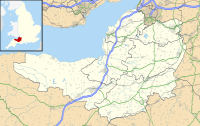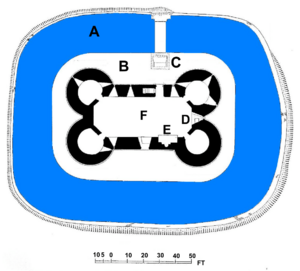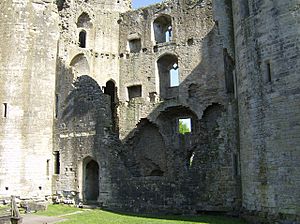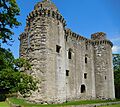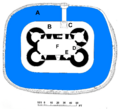Nunney Castle facts for kids
Quick facts for kids Nunney Castle |
|
|---|---|
| Somerset, England | |

In 2018
|
|
| Coordinates | 51°12′37″N 2°22′42″W / 51.2101754°N 2.3783328°W |
| Site information | |
| Owner | English Heritage |
| Open to the public |
Yes |
| Condition | Ruined |
| Site history | |
| Materials | Lias Oolite stone |
| Events | English Civil War |
Nunney Castle is an old castle in Nunney, a village in Somerset, England. It was built in the late 1300s by Sir John Delamare, who made money fighting in the Hundred Years' War. This castle has a moat and a unique design, which some think was inspired by French castles.
It was updated in the late 1500s but got damaged during the English Civil War. Now, it's a ruin, but still amazing to see! Today, English Heritage looks after it as a place people can visit. A famous historian, Nikolaus Pevsner, even called it "the most impressive castle in Somerset" because of its beauty.
Contents
Discovering Nunney Castle's Past
Building the Castle: The 1300s
Nunney Castle was built near the village of Nunney in Somerset. Sir John Delamare was a soldier who became rich during the Hundred Years' War against France. In 1373, he got special permission from King Edward III to build a castle. This new castle would stand where his old, unfortified house used to be.
The castle was built around a strong stone tower, called a keep. It was about 18 meters long and 7 meters wide inside, and 16 meters tall. It had four round towers at each corner. The walls were very thick, about 2.4 meters, and made from strong stone.
The castle had three main floors. The ground floor likely held the kitchen and other service areas. The upper floors were for living. The top floor was where the family lived. The castle had windows and fireplaces, but the main hall might have been a bit dark. The stairs were also quite narrow.
The castle had a small entrance, reached by a drawbridge over a wide moat. The moat was about 3 meters deep and went right up to the castle walls. This made it hard for attackers to get close. A low wall, about 3.6 meters high, surrounded the moat. On the east side, Nunney Brook acted as a natural defense instead of a wall.
For a long time, historians thought Nunney Castle's design was copied from French castles. It looks a lot like the Bastille in Paris, for example. Also, the machicolations (holes in the walls to drop things on attackers) were common in French castles.
However, some historians now think Nunney Castle was a bold and unique English design. It was similar to other strong tower-keeps built in England around that time. These castles were built for very rich people to live in comfort and show off their wealth.
Changes Over Time: The 1400s to 1600s
After Sir John Delamare, Nunney Castle was passed down through his family. Later, it went to the Poulet family through marriage. The Poulets owned the castle for most of the 1400s. However, their main home was Basing Castle, so they didn't live at Nunney much.
In the late 1500s, the castle was updated, probably by the Prater family who owned it then. The windows were made larger to let in more light. A grand staircase was added in one of the towers. A special terrace was built around the inside of the moat, making the moat wider.
The English Civil War: The 1600s
The Prater family, who owned Nunney Castle, were Catholic. When the English Civil War started in 1642, they supported King Charles I against Parliament. As the war continued, the King's side began to lose.
In September 1645, a Parliamentary army, led by Lord Fairfax and Oliver Cromwell, arrived in Somerset. They surrounded Nunney Castle on September 18. Colonel Richard Prater, who was in charge of the castle, refused to give up. So, the Parliamentary army used cannons to attack the north side of the castle, breaking through the wall.
Richard Prater kept fighting, even raising a flag with a crucifix to challenge them. But after two days, the castle's defenders surrendered.
Because the cannons had already damaged the castle, it was not deliberately destroyed (or 'slighted') like many other castles after the war. Richard Prater was not allowed to return to the castle. His son, George Prater, only got Nunney back after King Charles II became king again in 1660.
The castle slowly fell into disrepair. In the 1700s, it was still in fair condition. In 1789, there was even a plan to use it for French prisoners, but they probably never came.
Nunney Castle Today: The 1900s and 2000s
By the 1900s, Nunney Castle was mostly a ruin and covered in thick ivy. On December 25, 1910, a part of the damaged north wall completely fell down. Most of the fallen stones were believed to have been taken by local people.
In 1926, the castle was in danger of falling apart even more. Its owner, Robert Bailey-Neale, gave the property to the First Commissioner of Works. This group started a project to restore and protect the castle.
Today, English Heritage manages Nunney Castle as a tourist attraction. It is also a scheduled monument, which means it's a nationally important historical site. The famous historian Nikolaus Pevsner called it "aesthetically the most impressive castle in Somerset" because of its beautiful design.
Images for kids


